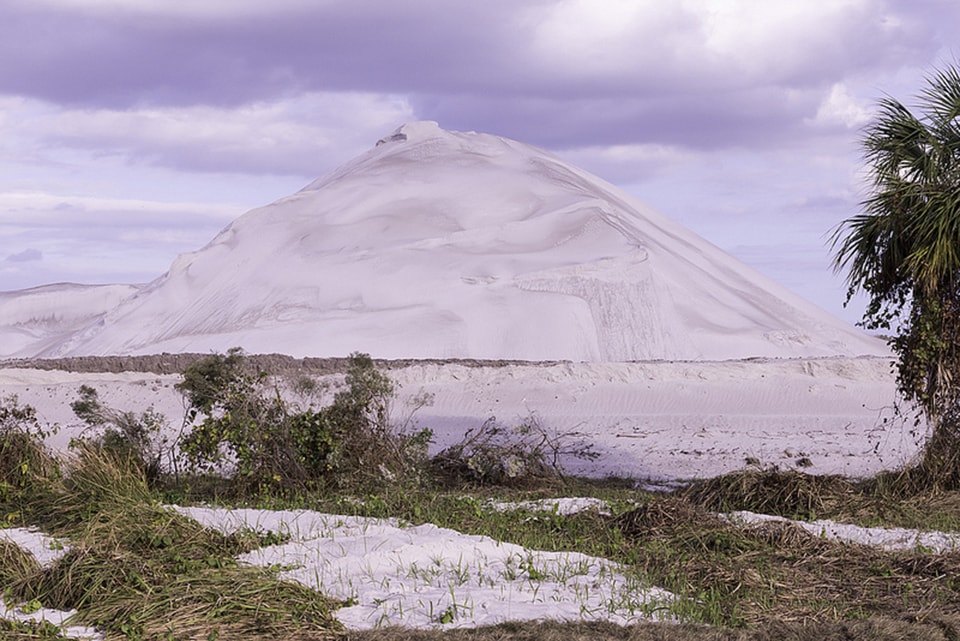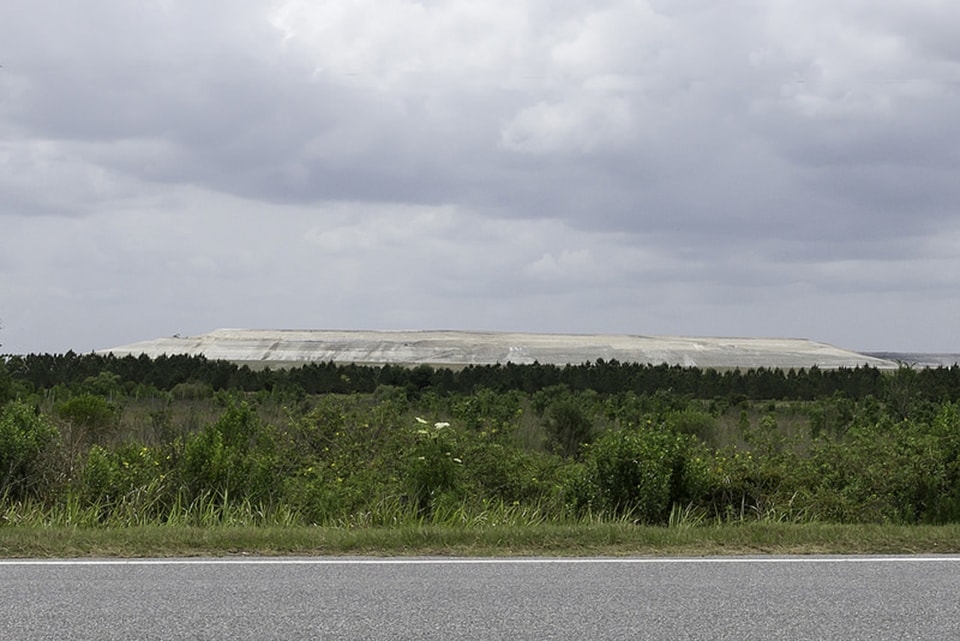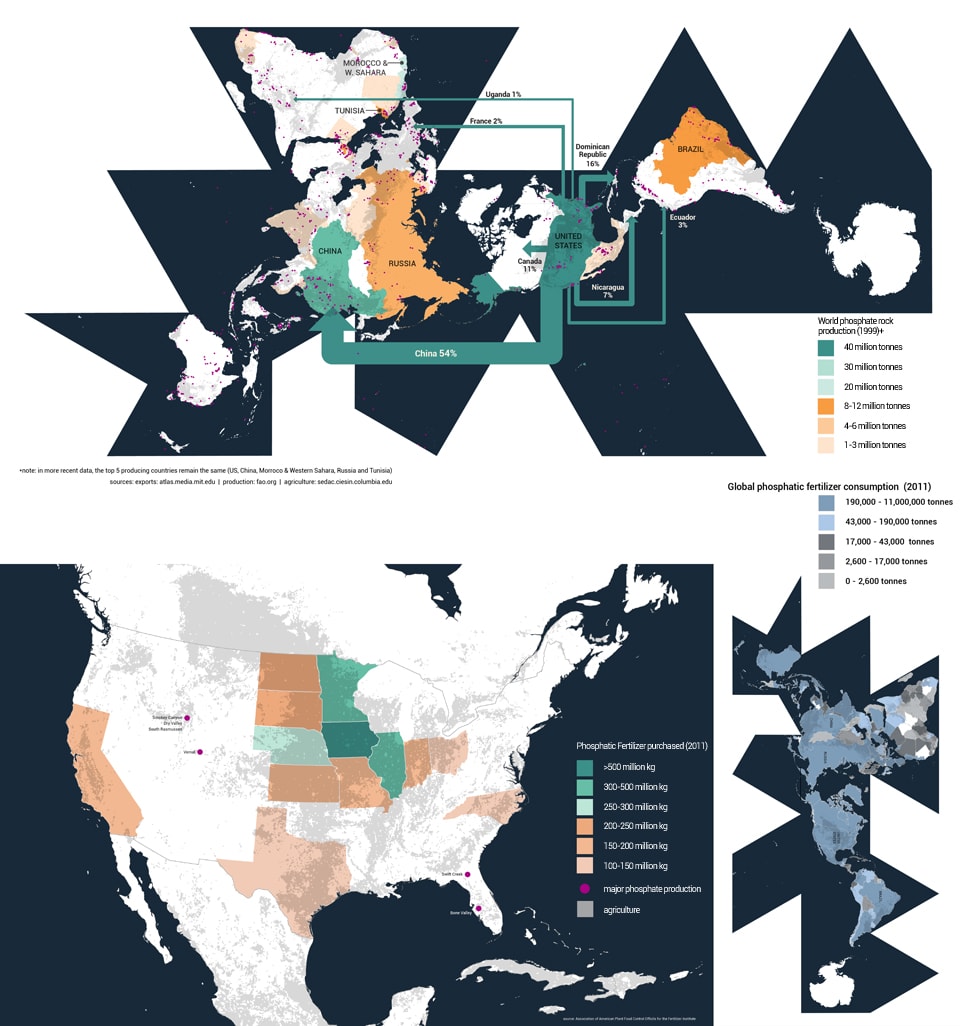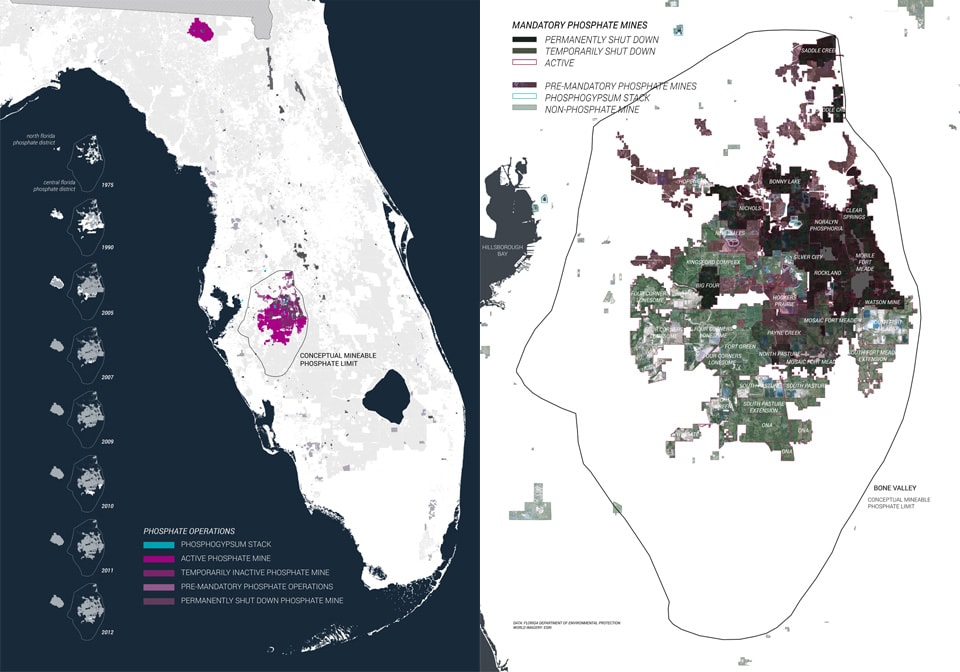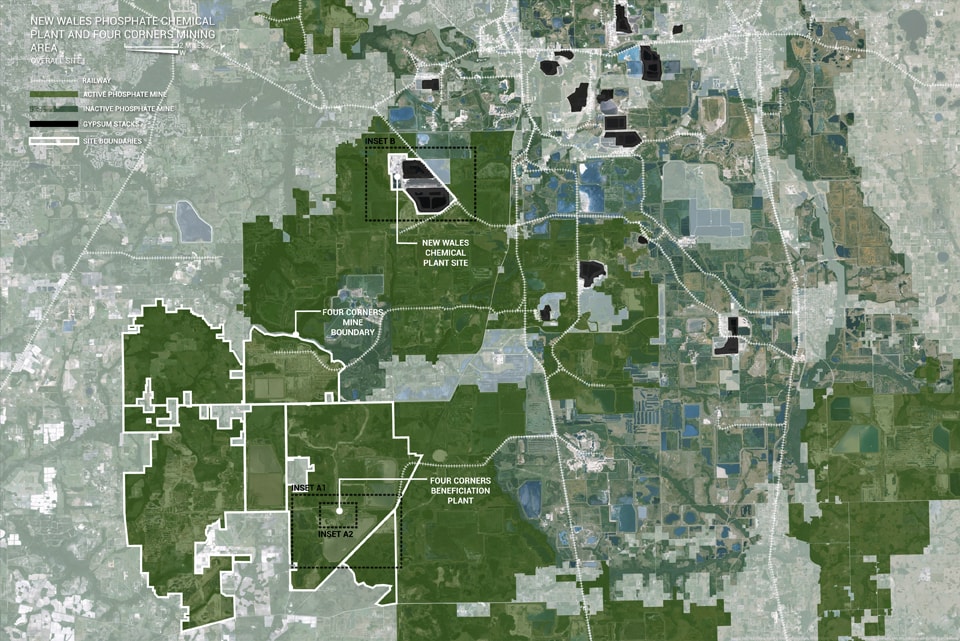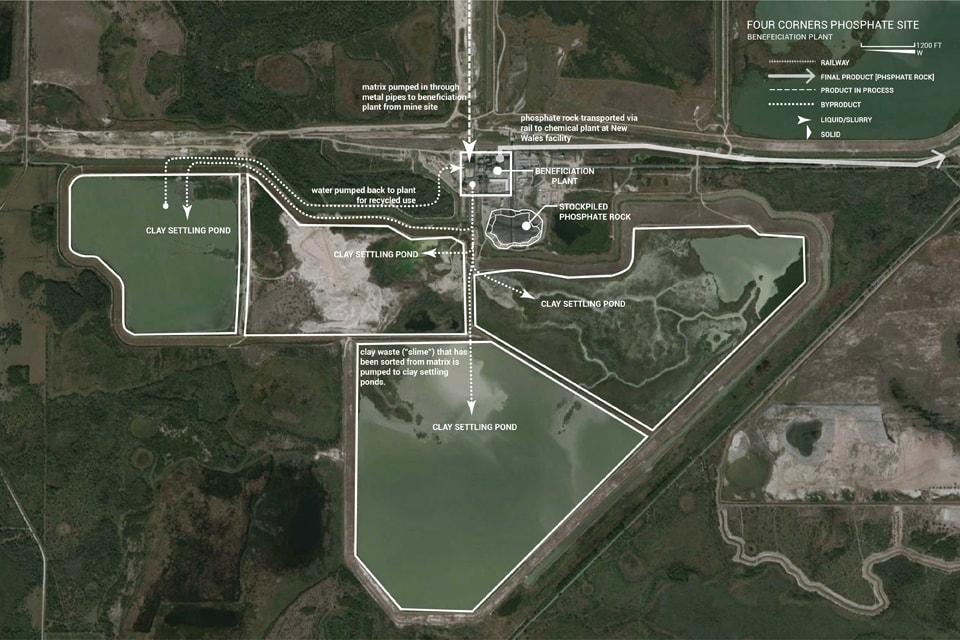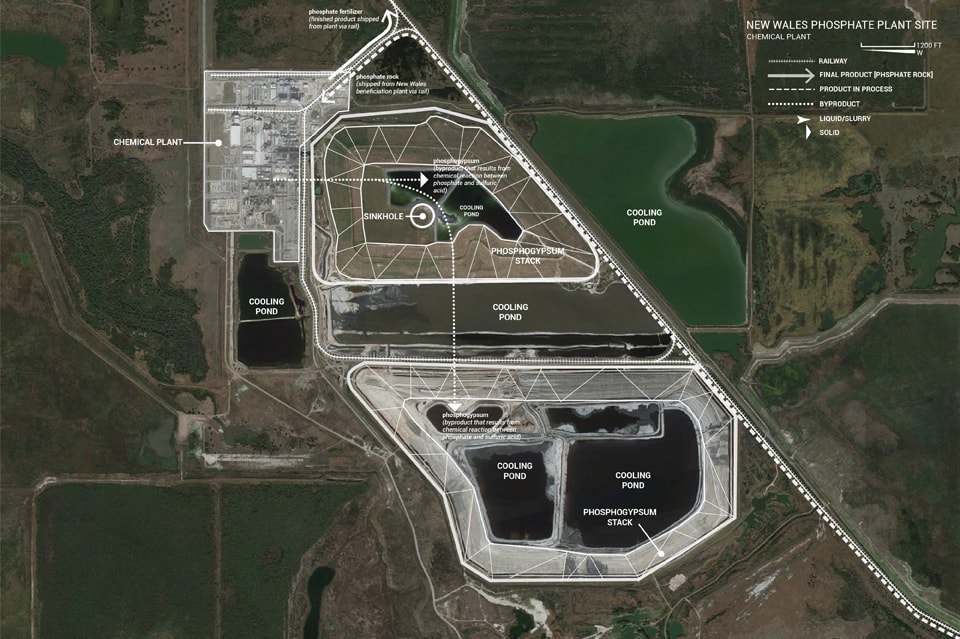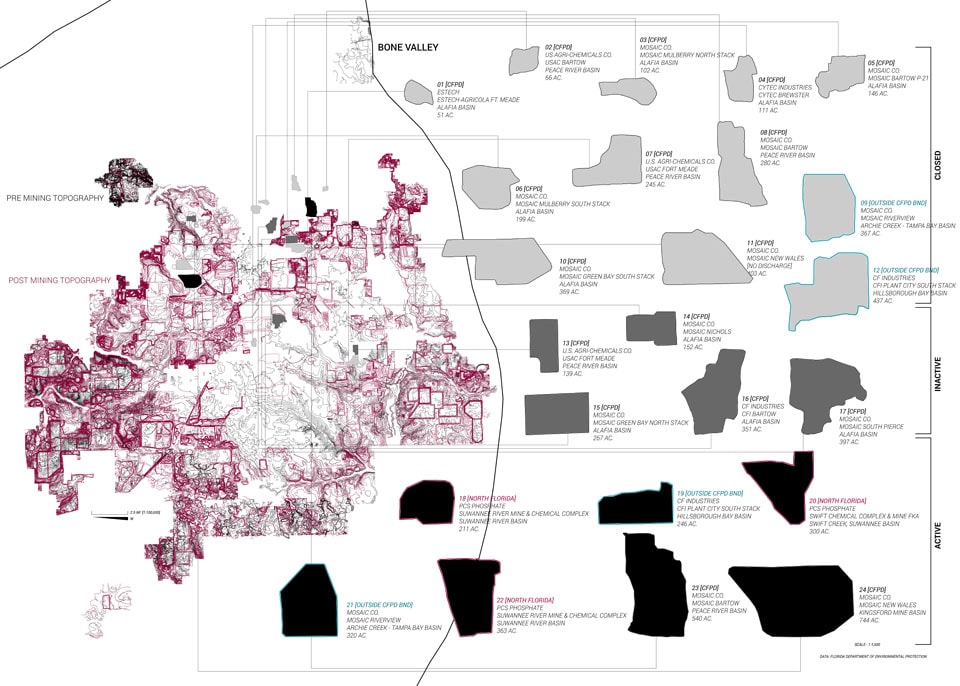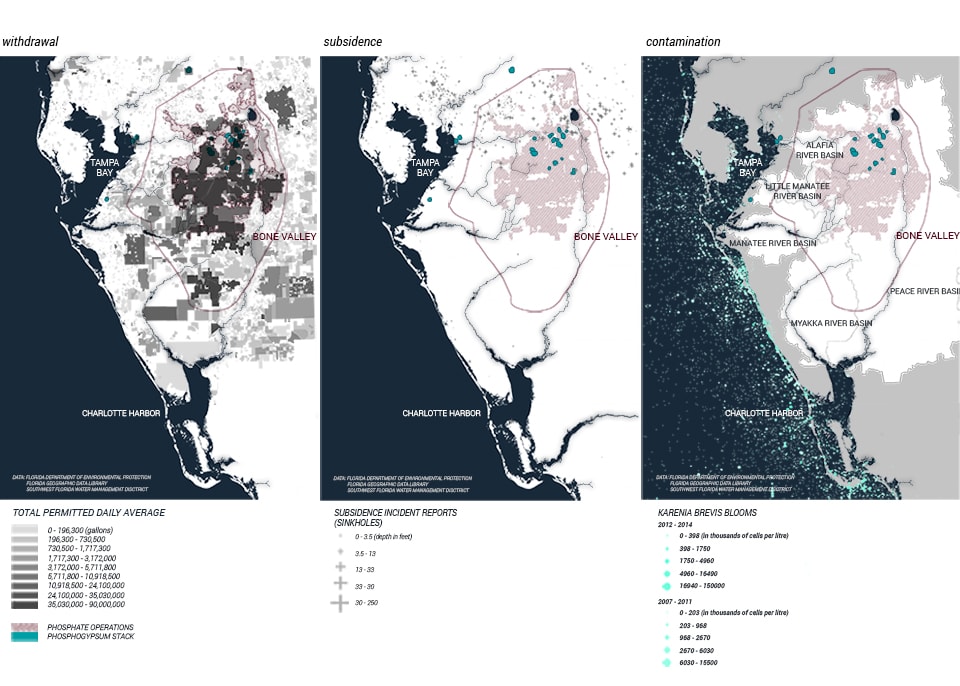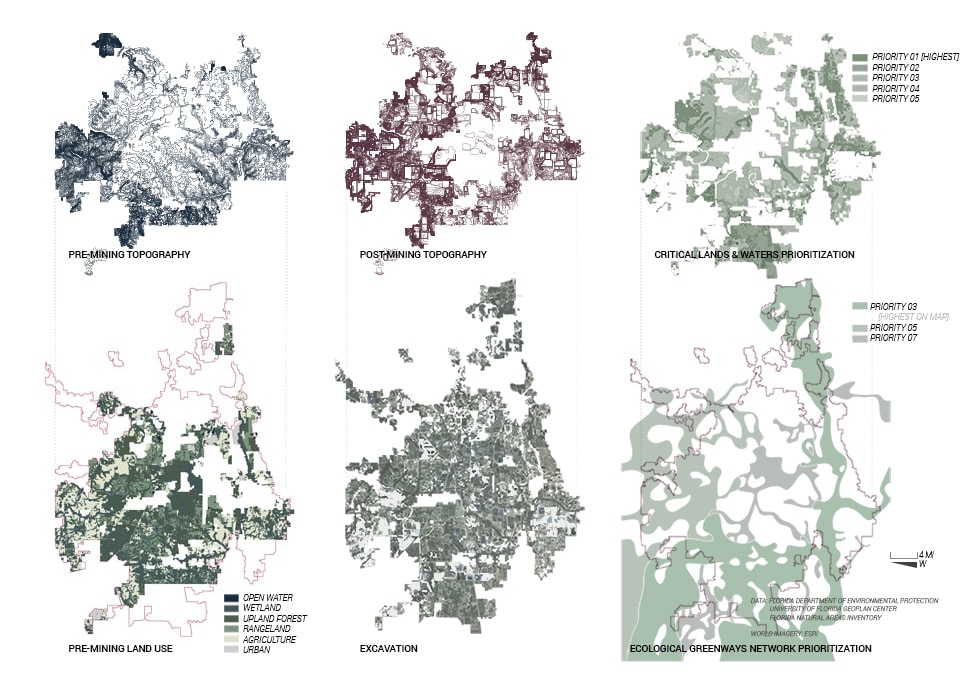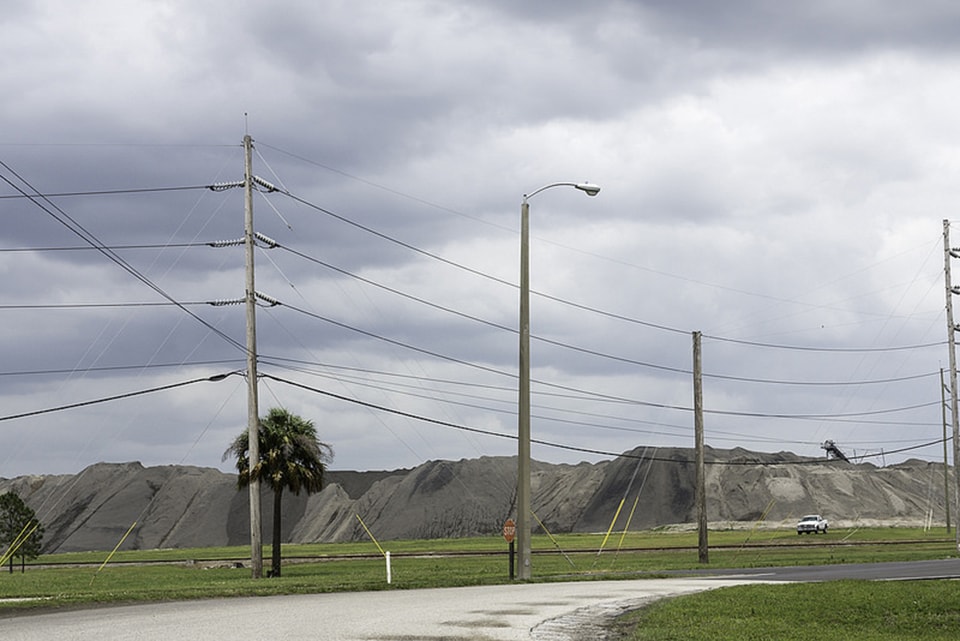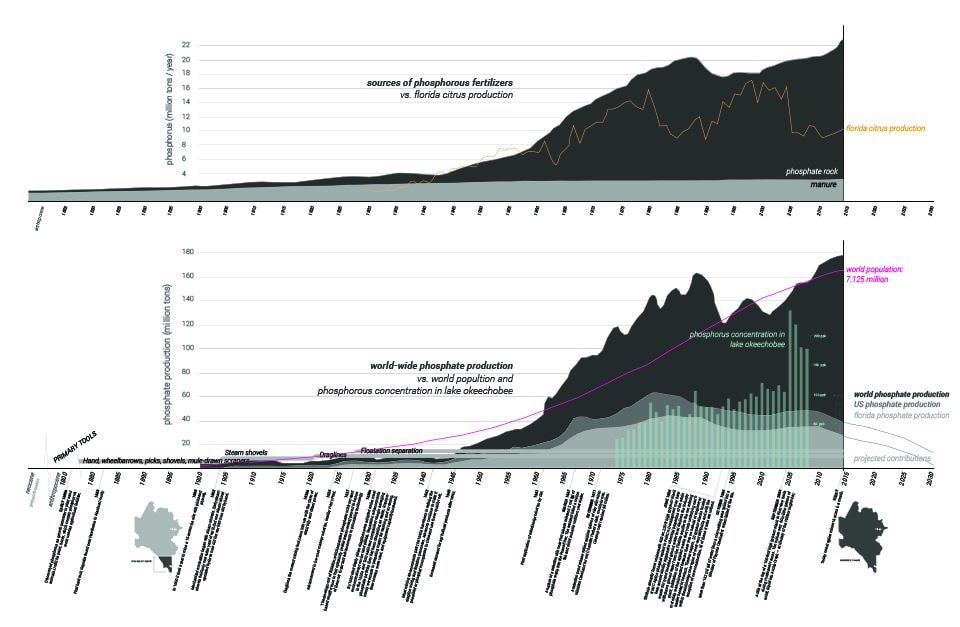June 27, 1994: routine inspections of a gypsum stack at IMC-Agrico’s New Wales facility, a phosphate mine in southwest Florida, discover an enormous black hole in the center of the stack. The stack, a by-product of processing operations at the mine, is itself enormous: 140 feet high and covering 430 acres. Even without the hole, it would be a looming presence in the south Florida landscape, where average elevations are merely ten or twenty feet above sea level.
With the emergence of the hole, the stack transforms from looming presence to immediate crisis. Gaping apocalyptically in helicopter-shot news photographs as contaminated water from the stack rushes in, the hole at first appears to be “120 feet in diameter and 180 feet deep” [1]. Before the hole can be closed, it expands to its final diameter of 160 feet and depth of 200 feet. Careful subsurface exploration reveals that the hole is, in fact, a sinkhole, a collapse not only in the gypsum stack itself but also in the porous underlying limestone. Millions of cubic feet of contaminated waste slurry pour directly through the hole into the Upper Floridan aquifer, a vital source of drinking water in South Florida. The hole is only closed when a team of remediation experts succeeded in plugging the subterranean cavern with thousands of cubic yards of concrete grout [2].
Phosphate rock pile, Brewster, Florida. (Photo © Richard Clapp,
used by permission)
Mining Bone Valley
The structure that failed in this incident, called a “gypstack,” is surprisingly common in Florida. The Florida Department of Environmental Protection currently identifies 24 such stacks, concentrated in a portion of central Florida known as “Bone Valley.” The stacks are universally large, ranging from 50 acres up to over 700 acres in surface area. They can be as tall as 200 feet [3]. These artificial mountains are the concentrated by-product of Florida’s most unique and globally significant extractive industry, phosphate mining.
A gypstack in Bartow, Florida. (Photo © Richard Clapp, used by permission)
Phosphate is a raw, naturally occurring form of phosphorus, which is one of the two most essential chemical inputs for the world’s most essential industry, agriculture. Unlike the other essential input, nitrogen, which is prevalent in the atmosphere and can be artificially fixed through the Haber process, phosphorus can only be obtained on industrial scale through mining its naturally occurring form, phosphate. Deposits of phosphate are relatively rare globally. The world’s four largest producers — China, the United States, Western Sahara/Morocco, and Russia — mine the bulk of global production [4].
While the majority of American-mined phosphate is used within the United States, significant volumes are shipped to other countries, particularly China, Canada, and Mexico. Within the United States, the bulk of production comes from four major mining locations, including the two in Florida. Every nation with significant industrial agriculture is a major phosphate consumer. (Image by authors)
Worldwide, agriculture consumes over forty million tons of phosphorus in fertilizer annually, and demand is projected to continue to grow steadily, particularly in Asia and South America [5]. This cycle of extraction, demand, and production links global processes of urbanization to the present and future of Florida’s extraction landscapes.
Florida is the epicenter of phosphate mining in the United States, and one of a small handful of globally significant mega-miners. At the beginning of the 21st century, Florida mined nearly 75% of the nation’s phosphate and about a quarter of all global phosphate [6]. The sheer scale of the impact of this extraction on the Floridian Peninsula is immense: by 1999, 300,000 acres of land were mined, a full one percent of the state’s surface area [7].
The geography of phosphate mining in Florida [left]; Mining company holdings in the Bone Valley Formation, where the majority of Florida’s phosphate is presently extracted [right]. (Images by authors)
While once spread more widely throughout the state, contemporary phosphate mining in Florida is confined to two large districts. The smaller is located in North Florida’s Hamilton County. The larger is Bone Valley, an inland district located east of Tampa Bay. Many other minerals are mined in Florida, particularly base construction materials such as sand, gravel, and limestone, but no other material is mined over such a large contiguous surface area.
The process of phosphate mining, from extraction to gypstacking. (Image by authors)
In phosphate mining, rock phosphate is extracted from the ground and, through a series of chemical and mechanical operations at plants located near the mines, transformed into phosphoric acid, which is used as agricultural fertilizer [8].
Location map for the New Wales Phosphate Chemical Plant and Four Corners Mine in Bone Valley. Insets reference images below. (Map Data: Google; Annotation by authors)
This process begins with surface strip-mining, performed by enormous draglines. A typical dragline bucket “is large enough to hold a truck or van” [9]. The overburden — earth not containing phosphorous deposits — is removed, permitting the extraction of the matrix, a mix of clay, sand, and phosphate. The extracted matrix is temporarily dumped into pits, where it is blasted by “high-pressure water guns,” producing a watery mixture known as slurry [10].
Four Corners Phosphate Site: Beneficiation Plant. (Map Data: Google; Annotation by authors)
The slurry is pumped to a beneficiation plant, where the phosphate is sorted out of the slurry [11]. The phosphate concentrate is dewatered and then transported by rail or truck to another plant, called the chemical (or fertilizer manufacturing) plant. The slurry that remains behind at the beneficiation plant is pumped into clay settling ponds, where sediment settles out and the water can be pumped off.
Four Corners Phosphate Site: clay settling ponds. (Map Data: Google; Annotation by authors)
Meanwhile, at the chemical plant, the phosphate is mixed with sulphuric acid to yield phosphoric acid. This acid is combined with anhydrous ammonia to produce phosphatic fertilizer, now ready for shipment to agricultural users.
New Whales Phosphate Plant Site with associated gypstacks. New Wales receives phosphate concentrate by rail from the Four Corners beneficiation plant.
(Map Data: Google; Annotation by authors)
This “wet process” at the chemical plant also has a significant by-product, phosphogypsum, which is the material that composes the stacks like the one that collapsed at New Wales. For every ton of phosphoric acid produced, five tons of this kind of gypsum are also produced [12]. Typically, this gypsum is itself converted into a slurry by mixing it with additional water and then pumped to a disposal stack — in turn made of previously-dried gypsum. The wet slurry sits in a diked containment pond atop the stack and, as the water evaporates, dried cake remains behind [13].
The stacks grow.
The gypsum stacks of Bone Valley sorted into closed (top), inactive (middle), and active (bottom). (Image by authors)
Reconfigurations
Phosphate mining operations have radically impacted Bone Valley and other Floridian landscapes, through both direct and indirect effects.
Phosphate mining requires great volumes of water for the processes of beneficiation and slurrification. In Bone Valley, this water is obtained through groundwater withdrawals, tapping the enormous series of layered aquifers which are contained in the porous soils and limestone bedrock of Florida. Throughout the Floridian peninsula, aquifers are the primary source of freshwater for household, industrial, and agricultural uses, bringing the phosphate industry into competition with other users such as private residents, who also depend on the aquifers.
Phosphate mining has a series of significant impacts on water. The mining industry is one of the largest consumers of groundwater in the Southwest Florida Water Management District [left]. Sinkhole formation [middle] is directly accelerated by this usage, while algal blooms [right] are promoted by runoff of the fertilizers produced from phosphates. (Image by authors)
Extensive drawdown of the aquifer system intensifies the risk of sinkhole formation and surface collapse — the phenomenon that led to the New Wales collapse [14]. Moreover, because of the direct linkages between subsurface and surface water flows in south Florida, aquifer drawdown impacts flow levels in surface waterways such as the Peace River, leading to increased salinity in downstream estuaries [15].
At the same time, phosphate applied to Florida’s many orange groves, sugarcane plantations, and other agricultural lands as fertilizer is a significant contributor to one of the state’s most pressing environmental problems: degradation of marine ecosystems including lakes, rivers, estuaries, and lagoons. In these waterbodies, excess agricultural nutrients (primarily phosphorus and nitrogen) generate eutrophic conditions and, combined with impacts like unwanted freshwater releases and excessive sediment loads, foster damaging (and even toxic) algal blooms, while harming species such as seagrasses and oysters that are foundational to food chains [16].
There is also potential for direct contamination of surface waterways from excavation activities. Activities at the chemical plant concentrate undesirable chemicals, including trace amounts of radioactive uranium and radium, in the phosphogypsum slurry. Acidic or even radioactive waters from gypstacks can infiltrate downward through the stack and contaminate groundwater [17]. Seepage waters may also contain heavy metals “at concentrations that may pose significant health risks” [18]. This is a particularly significant concern with older stacks that predate contemporary regulations requiring liners beneath the stacks, but even when stacks are properly constructed, failure remains a distinct possibility. For instance, in 2011, “millions of gallons of potentially contaminated water” was dumped into Tampa Bay to prevent a “catastrophic collapse” when the protective lining of a reservoir “carved out of radioactive gypsum stacks” “sprang a leak.” A local environmentalist noted: “there’s no such thing as a liner that doesn’t leak over time” [19].
The topographic changes created and areas scraped by excavation conflict with goals of landscape conservation and habitat connectivity. (Image by authors)
The scale of the area recontoured by surface mining also poses significant environmental challenges. Within Bone Valley, native habitat has been lost, soils removed, and a variable landscape of barren pits and piles has replaced the flat expanses typical of South Florida, where small changes in elevation produce large ecological differentiations between hammocks and wetlands. These disturbances are so large in scale and so intense that it has been estimated that, without further human intervention, the full recovery of ecological productivity would take half a millennium [20]. As a result, efforts at restoration of ecosystem function within phosphate mined lands require an extraordinary “degree of repair” [21].
Phosphate mining near Polk City in Bone Valley.
(Photo © Richard Clapp, used by permission)
Further into the future, the gypsum stacks themselves may present the most significant marker of the impacts of phosphate mining. Their sheer bulk ensures that, unless they are mined at some future date, they will remain largely in place, while, over long periods of time, their future stability and behavior is uncertain: as an industry report notes, even “a closed stack continues to be dynamic” [22].
Landform Monuments
The easiest way to reduce these impacts would be to slow or stop phosphate mining. But there is no indication that this will happen until global mining resources are exhausted.
It is, however, conceivable that phosphate mining in Florida might be reduced. Yet to cease mining without first reckoning with broader systems of production and consumption that rely on the use of phosphorus would arguably be more ethically problematic than continuing to mine. Contemporary agriculture in the United States is dependent on phosphorus applications; contemporary urbanization is, in turn, dependent on industrial agriculture. Until that changes (and the long-term sustainability of industrial agriculture is deeply questionable), the necessary result of reducing production in the United States is to export our collective environmental impacts to other nations — effectively, ecological imperialism [23].
Phosphate mining in Florida radically accelerated and intensified in the later half of the 20th century, in tandem with population growth, increases in agricultural production, and the evolution of larger mining machinery such as draglines. Environmental damages such as phosphorus contamination in Lake Okeechobee have kept pace. (Image by authors)
Accepting this leaves designers concerned by the effects of phosphate mining with a responsibility to engage existing extraction landscapes, such as Bone Valley. But what role is there for design in these mined landscapes, in the extraction of phosphate, in Florida in particular? What might design offer that the scientists, engineers, industries, and other actors already engaged in mine operations do not?
One possible answer is that landscape architects might contribute to post-operative reclamation efforts, such as watershed-scale restoration plans, the design of discrete sites like wetlands constructed on strip-mined land, or the adaptive management of large-scale environmental engineering [24]. This not at all far-fetched: faculty from the University of Florida School of Landscape Architecture and Planning, for instance, have been deeply involved in the spatial planning of the Florida Ecological Greenways Network, which includes priority corridors in Bone Valley [25]. The fragmented structure of mine leases and ownership creates complex spatial problems that benefit from the application of landscape intelligence [26].
Designers might also directly engage operative terrain. In her essay “Big Nature,” landscape architect Jane Amidon calls for a shift in perspective and a recognition that “sites are producers — living systems — linked to supply and demand networks.” Along with this reframing, Amidon advocates for a more engaged role for design in which “the practice of landscape moves beyond reclamation, [and] there is a proactive, rather than reactive stance” [27].
Phosphate rock pile, Brewster, Florida. (Photo © Richard Clapp,
used by permission)
While some landscape practitioners have begun to operate in terrains of extraction, much of this “proactive” work is focused on landscape systems as replacements for earlier generations of infrastructural design; for instance, the replacement of mechanical wastewater treatment with constructed wetlands.
Extractive operations, however, cannot be replaced by landscape infrastructures. Landscape infrastructures operate by decentralizing and distributing infrastructural functions, by replacing industrial structures with landscape processes: a concrete drainage channel becomes a series of braided, planted streams; a fossil fuel plant becomes an array of wind farms [28]. Extraction is fundamentally acceleration, energy burned and mechanization applied to produce rapid anthropogenic counterparts to geologic processes. Consequently, extraction presents a radically different design challenge than the transformation of “sites [into] producers” and “living systems” described by Amidon. Engaging extraction requires the orchestration of new ecologies, landforms, and hydrologies in dialogue with on-going industrial processes.
This dialogue could begin with the engagement of the operational practices and spatial logics of phosphate extraction, such as the placement and operation of clay settling areas, decisions about the sequencing of excavations in time and space, the organization of gypstacking, or interfaces between mined lands and adjacent uses. Designed versions of these operations might better balance present with future, tying together present mineral production and future ecological productivity in a careful spatial and temporal choreography, rather than waiting to construct new ecologies on damaged lands after operations cease.
This engagement is made difficult, though, by the dominance of efficiency as a paradigm for configuring extractive operations. Writing about links between architecture and resource extraction, designer Dan Adams notes that efficiency is often invoked in extractive contexts in a manner that effectively negates the agency of design — with its promiscuous desire to consider cascades of competing ends. This is particularly evident in the case of scarce industrialized natural resources such as phosphate [29]. In such contexts, Adams argues, “the role of design is confined at best to reactionary models of minimizing negative impacts, designing a process that is as frictionless and disengaged with local systems of human ecology as possible, or designing and/or re-envisioning the post-industrialized landscape once the resource is depleted.” For Adams, this logic makes a case for focusing designed engagement on the extraction of abundant natural resources, such as salt, where efficiency is less determinative of extraction operations and practices. But even within scarce resource systems, the bounds of efficiency are artificial: certain elements are included by human volition when measuring efficiency, while others are excluded, or, in the language of economics, externalized. Designed operations that draw larger boundaries may excavate efficiencies that lurk unseen beneath the bounds currently drawn.
This task might be best understood — and include the most latitude for design agency — as urgent not only materially and environmentally (as a response to the series of environmental challenges outlined above), but also culturally. The deep entanglement of industrial agriculture with contemporary American urban ways of life implicates all Americans in phosphate mining’s consequences. Furthermore, that mining’s byproduct topographies suggest a deeper and more ironic entanglement. Industrial agriculture is one component of the larger global system of urbanization, which is dependent on extractive processes, broadly, to speed urban metabolisms with extracted inputs [30]. These accelerated metabolisms are, in turn, responsible for globally-scaled environmental changes like the accumulation of greenhouse gases, which is driving sea level rise. That same sea level rise is likely the single greatest threat to continued human settlement in South Florida [31]. It is deeply ironic that some of the highest (and thus, in light of sea level rise, most permanently inhabitable) ground in South Florida — the gypstacks — owes its existence to one of the extractive processes supporting the acceleration that is threatening inhabitation.
The task of imagining alternate operative models for extraction, then, becomes a fundamental question about how we, as a society, collectively envision our collective future. In the book Dark Matter and Trojan Horses, designer and urbanist Dan Hill asserts that “[design’s] core value… is addressing meaningful, genuinely knotty problems by convincingly articulating and delivering alternative ways of being” [32]. This is design as cultural imagination, and it has not yet been applied to extraction.
In order to address the pressing landscape issues of South Florida, fundamentally new modes of settlement must be imagined. Landscape modification and imagination has transformed this landscape in the past, and may do so again. The indigenous peoples of south Florida, such as the Calusa, for instance, relied not only on canals and shoreline modifications — which contemporary Americans have also constructed — but also constructed topographic platforms that supported a form of networked urbanization in and with the glades, hammocks, and mangroves of south Florida [33]. Convincing articulation of not only the possibility but the appeal of new modes of settlement might successfully challenge the rigid logic of efficiency as it is currently understood.
Phosphate mining is producing enormous accidental monuments to the current American way of life; what other monuments to alternative ways of being could we choose to make?
Portions of this article draw on thoughts Holmes first developed in a 2010 post on mammoth, “the dead sea works,” as well as a pair of talks he gave at LSU and Cornell in spring 2013, on the role of landscape architecture in “operative terrain” — active industrial, infrastructural, and extractive landscapes.
 Rob Holmes is an Assistant Professor of Landscape Architecture at the University of Florida. His work explores new modes of design and planning in light of reciprocal relationships between contemporary urbanization, infrastructural networks, and large-scale anthropogenic landscape change. Currently, the primary loci for these investigations are the “Four Coasts” project, an examination of the human manipulation of sediments in four coastal regions of North America with the Dredge Research Collaborative (co-founded by Holmes), and design research on hydrological control infrastructures in south Florida, supported by the Graham Foundation for Advanced Studies in the Fine Arts. Prior to joining the University of Florida, he practiced landscape architecture with Michael Vergason Landscape Architects and taught in Virginia, Louisiana, and Ohio.
Rob Holmes is an Assistant Professor of Landscape Architecture at the University of Florida. His work explores new modes of design and planning in light of reciprocal relationships between contemporary urbanization, infrastructural networks, and large-scale anthropogenic landscape change. Currently, the primary loci for these investigations are the “Four Coasts” project, an examination of the human manipulation of sediments in four coastal regions of North America with the Dredge Research Collaborative (co-founded by Holmes), and design research on hydrological control infrastructures in south Florida, supported by the Graham Foundation for Advanced Studies in the Fine Arts. Prior to joining the University of Florida, he practiced landscape architecture with Michael Vergason Landscape Architects and taught in Virginia, Louisiana, and Ohio.
 Christie Allen is a recent graduate of the University of Florida’s Master of Landscape Architecture program, where she wrote her thesis on resilience planning through recentralization as an alternative to retreat in the coastal zones of Florida. While at UF, her research and interests aligned with coastal flux and its human management, environmental cartography, and the uniquely constructed and manipulated landscapes and infrastructures of South and Central Florida. She now works as a landscape designer in Orlando.
Christie Allen is a recent graduate of the University of Florida’s Master of Landscape Architecture program, where she wrote her thesis on resilience planning through recentralization as an alternative to retreat in the coastal zones of Florida. While at UF, her research and interests aligned with coastal flux and its human management, environmental cartography, and the uniquely constructed and manipulated landscapes and infrastructures of South and Central Florida. She now works as a landscape designer in Orlando.
 Lauren Sosa is currently a doctoral student in Design, Construction, and Planning at the University of Florida. She has a Bachelor of Landscape Architecture from the Pennsylvania State University. After she spent a few years in professional practice in South Florida, Lauren returned to academia and received a Master of Landscape Architecture from the University of Florida. Lauren’s research interests include: the role of landscape architects in less-developed contexts, international development, postcolonial dynamics in landscape, and design communications.
Lauren Sosa is currently a doctoral student in Design, Construction, and Planning at the University of Florida. She has a Bachelor of Landscape Architecture from the Pennsylvania State University. After she spent a few years in professional practice in South Florida, Lauren returned to academia and received a Master of Landscape Architecture from the University of Florida. Lauren’s research interests include: the role of landscape architects in less-developed contexts, international development, postcolonial dynamics in landscape, and design communications.
Notes
[1] Tom Palmer, “Gypsum stack sucked down by sinkhole,” Ocala Star-Banner, June 30, 1994, 2B.
[2] These details are drawn from the website of the civil engineering firm responsible for closing the sinkhole, Ardaman & Associates Inc. The specific page is http://www.ardaman.com/award3.htm.
[3] “About Phosphogypsum,” Environmental Protection Agency, accessed 13 April 2015, http://www.epa.gov/radiation/neshaps/subpartr/about.html#stacks.
[4] U.S. Geological Survey. “Mineral Commodities Summary: Phosphate Rock,” by Stephen M. Jasinski, February 2014. Accessed January 31, 2015. http://minerals.usgs.gov/minerals/pubs/commodity/phosphate_rock/mcs-2014-phosp.pdf
[5] Ibid.
[6] Mark T. Brown, “Landscape restoration following phosphate mining: 30 years of co-evolution of science, industry and regulation,” Ecological Engineering 24, no. 4 (2005): 314.
[7] “Phosphate Primer,” Florida Industrial and Phosphate Research Institute, accessed January 31, 2015, http://www1.fipr.state.fl.us/PhosphatePrimer/0/AE4CF5150A93866485256F800079933B.
[8] Brown, 309-310.
[9] “Phosphate Mining Today,” Florida Industrial and Phosphate Research Institute, accessed April 13, 2015, http://www.fipr.state.fl.us/about-us/phosphate-primer/phosphate-mining-today/.
[10] “Phosphate Mining,” Mosaic, accessed 13 April 2015, http://www.mosaicco.com/florida/mining.htm.
[11] “Phosphate Beneficiation,” Florida Industrial and Phosphate Research Institute, accessed April 13, 2015, http://www.fipr.state.fl.us/about-us/phosphate-primer/phosphate-beneficiation/.
[12] P.M. Rutherford, M. J. Dudas, and R. A. Samek, “Environmental impacts of phosphogypsum,” Science of the total environment 149, no. 1 (1994): 2.
[13] This process is described in detail in Anwar Wissa’s “Phosphogypsum Disposal and the Environment”, an industry publication available on the Florida Industrial and Phosphate Research Institute’s website at http://www.fipr.state.fl.us/pondwatercd/phosphogypsum_disposal.htm.
[14] U.S. Department of the Interior, U.S. Geological Survey, Land Subsidence in the United States, edited by Devin Galloway, David R. Jones, and S.E. Ingebritsen, Circular 1182 (Washington, D.C.: United States Government Printing Office, 1999), http://pubs.usgs.gov/circ/circ1182/pdf/15WCFlorida.pdf.
[15] “Florida Phosphate Mining,” Sierra Club Florida, accessed 31 January 2015, http://florida.sierraclub.org/phosphate.asp.
[16] Michael Wines, “Death of Manatees, Dolphins, and Pelicans Point to Estuary at Risk,” The New York Times, August 7, 2013.
[17] Rutherford et al. 18. Phosphogypsum contains naturally occurring radioactive elements, and mining exposes and concentrates the radioactivity (10-60 times background levels). According to Rutherford et al., the “EPA has determined, however, that the risks associated with stacking phosphogypsum are in line with acceptable risk practices”
[18] “About Phosphogypsum,” Environmental Protection Agency, accessed 13 April 2015, http://www.epa.gov/radiation/neshaps/subpartr/about.html#stacks.
[19] Dale White, “Water leaking from mound of radioactive waste near Port Manatee,” Sarasota Herald-Tribune, June 1, 2011, http://www.heraldtribune.com/article/20110601/BREAKING/110609978.
[20] Brown, 315.
[21] Ibid., 325.
[22] Dean Kleinschmidt, “Phosphogypsum Stack Closure,” Phosphate Fertilizers and the Environment: Proceedings of an International Workshop, March 23-27, 1992, Tampa, FL (1992): 185-192.
[23] Brett Clark and John Bellamy Foster demonstrate the inequalities at play in one such historic exchange, the 19th-century trade in guano and nitrates (like phosphorus, agricultural fertilizers), in their article “Ecological Imperialism and the Global Metabolic Rift” (International Journal of Comparative Sociology, 2009, Vol 50(3-4): 311-334).
[24] Brown, 322-326.
[25] The Florida Ecological Greenways Network, UF Center for Landscape Conservation Planning, http://conservation.dcp.ufl.edu/FEGN.html.
[26] Gale Fulton, “Towards Landscape Intelligence,” LA! Journal of Landscape Architecture 31 (April-June 2011): 46-53.
[27] Jane Amidon, “Big Nature,” in Design Ecologies, eds. Lisa Tilder and Beth Blostein, (New York: Princeton Architectural Press, 2010), 165.
[28] Pierre Bélanger, “Landscape as infrastructure,” Landscape Journal 28, no. 1 (2009): 79-95.
[29] Dan Adams, “Industrialization of Abundant Natural Resources: Absorbing Efficiencies,” The Expanding Periphery and the Migrating Center: Paper Proceedings from the 2015 Association of Collegiate Schools of Architecture Annual Meeting (2015): 475-481.
[30] See, for instance, Peter Baccini’s discussion of the role of phosphorus in metabolic processes of urban systems in “Understanding and Designing the Metabolism of Urban Systems” in New Geographies 06: Grounding Metabolism, eds. Daniel Ibanez and Nikos Katsikis, 29-37.
[31] Florida Oceans and Coastal Council, “Sea-Level Rise in Florida,” December 2010. Accessed 14 May 2015, http://seagrant.noaa.gov/Portals/0/Documents/what_we_do/climate/Florida%20Report%20on%20Climate%20Change%20and%20SLR.pdf.
[32] Dan Hill, Dark Matter and Trojan Horses: A Strategic Design Vocabulary (Strelka 2012).
[33] Laura Ogden, Swamplife: People, Gators, and Mangroves Entangled in the Everglades. (Minneapolis: University of Minneapolis Press, 2011), 5-6.

